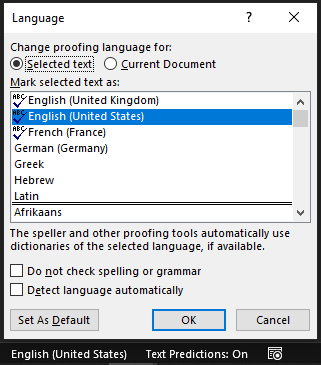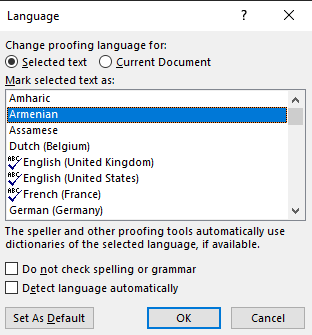The DOCX file format is an entrenched standard for documents in biblical studies.1 And beyond that, the particular, proprietary way Microsoft Word interprets and implements the format is broadly, if implicitly, standardized as well.
In short, pending further technical innovation, other word processors will continue to produce “DOCX” files. But those files won’t be 100% compatible with Word and vice versa.
So, using Word to craft your research allows you to avoid numerous file format headaches when preparing or exchanging files. But as you use it, you’ll encounter some quirks that Word has as well. One of these is in how Word manages—or doesn’t manage—its language list.
Word’s Language List

By default, Word shows a “status bar” at the bottom of the screen. That bar provides information about
- the document overall,
- your location in the document, and
- common options for how to view the document.
Another specific piece of information the status bar provides by default is the composition language for your current place in the document.
Clicking that language will open the Language dialog box with the language list at the top above a double line.
If you’re writing a complex document with multiple languages, the Language box allows you to easily change the language of a given portion of text. Doing so means you’ll have fewer “red squiggly lines” calling you to correct a text that’s simply getting misinterpreted by the spellchecker.
In theory, you could let Word identify different languages for you by checking the “Detect language automatically” box. But that has bad results for Greek diacritics.
A Hard-to-modify Tool

But let’s say that you throw a few errant keystrokes or do a few errant mouse clicks.
Maybe you choose a language from the list incorrectly. Or maybe you quote some Armenian text once but have no need to do so routinely.
By default, each new language you select from the Language box ends up above the box’s doubled line. The list gets longer and longer, and that list follows you from one document to the next.
So, every time you use or mistakenly select a new language from the list, the messier the list becomes, and the more cumbersome it gets to use.
And in Word for Windows, there’s no solution for this mess.2 Once a language is in the list, there’s no way to remove it. Arguably, there should be. But thankfully, there is a way to clean up your language list—namely, by using the Windows registry.
Word and the Windows Registry
Word logs which languages it puts at the top of the language list in the registry under HKEY_CURRENT_USER\SOFTWARE\Microsoft\Office\16.0\Common\LanguageResources\.
Before editing the registry, it’s always a good idea to back it up in case something breaks. You should also ensure that you can restore as needed from your backup.
The places to check and entries to change are, however, pretty straightforward in this case. But you may want to have a language code table ready for easy reference in case you’re not sure which language is which.
Before each step, close Word. Then make the indicated registry change, and reopen Word to see if your language list is as you want it. If it is, you’re done. If not, repeat with the next step.
- Under
~\EnabledEditingLanguages, leave the(Default)entry, but try deleting entries for the languages you don’t want to appear above the doubled line in the language list.3 - Under
~\LocalCache, find the entryAuthoringLanguagesList. Right-click this entry, and choose to modify it. Delete from theValue data:box any languages you don’t want to appear above the doubled line in the language list. You’ll also delete the accompanying semicolon beside that language in theValue data:box. When you’re done, there should be no semicolon at the start or end of the list in theValue data:box, and each language left in the box should be separated by exactly one semicolon. - Under
~\LocalCache\[your Microsoft 365 username or Word profile name], find the entryAuthoringLanguagesList. Repeat the process from step 2 above. (For me personally, this step has done the trick every time so far.)
Conclusion
Depending on your project, writing in biblical studies can easily require documents containing several different languages. For that purpose, Word’s language list can be a helpful tool.
And even when it gets bogged down with more languages than you need or want, the few straightforward steps above will help you tidy things up and get back to writing.

Tired of fighting with Word? Want to be done with frustrated hours fussing over how to get the formatting you need?
My new guide shows you how to bypass all of this so you can let Word work for you while you focus on your research.

For students in any graduate program, mastering the full range of available research tools is crucial for efficient and consistent productivity. Dr. Stark has mastered these tools—the most important of which is Microsoft Word…. Students eager to take their work to the next level would do well to follow Dr. Stark’s in-depth guidance.
Header image provided by the Noun Project. ↩
MacOS handles the language list differently, but I’ve not been able to test whether this same issue occurs there. If it does, I would be interested to hear in the comments from Word for MacOS users who encounter it and who may have found a solution. ↩
For this idea and the prompt it provided to look into the steps below, I’m grateful to “How to Remove Language above Double Line in Mark Selected Text As:,” Narkive News Group Archive, n.d. ↩

Leave a Reply